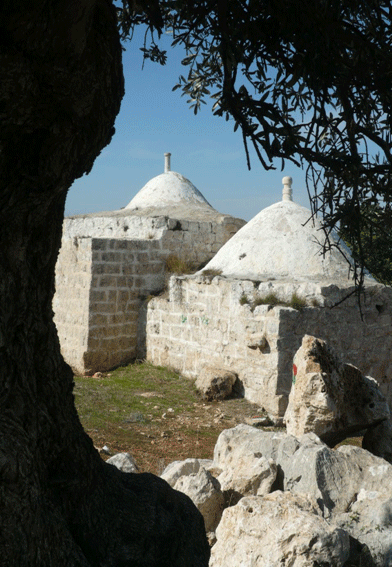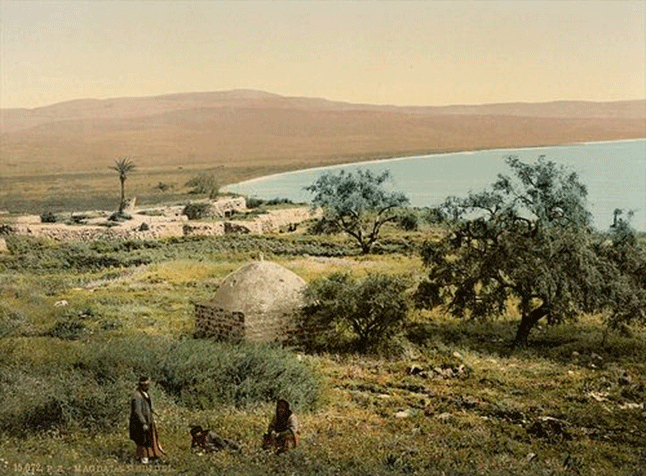 An hour’s walk from the village of Deir Ghassaneh, along a dirt track lined with olive and oak, the traveler arrives at a domed, white-painted shrine standing alone on the hillside.
An hour’s walk from the village of Deir Ghassaneh, along a dirt track lined with olive and oak, the traveler arrives at a domed, white-painted shrine standing alone on the hillside.
A stone wall encloses two or three unmarked tombs. Beneath the arches, graffiti has been scrawled across the walls with charred ends of firewood.
It is known as the shrine of al-Majdhoub – 'the one called to God’. But there are no candles, no prayer carpets. Nothing to explain who lies in these graves, or what thread of belief once connected the shrine to the village.
Throughout rural Palestine, on hilltops or at the edge of towns, there are shrines and sanctuaries like this. Why were they built in these lonely places? And what did they mean to the generations of men and women who came to pray at these walls?
Beginnings
Sufism escapes definition. In the West, it is known largely through the work of the great Persian writer Jalaleddin Rumi, whose poems dance around a kind of intimate, overwhelming experience of the divine that lies at the heart of many of the world’s mystic traditions. But this personal form of illumination is just one thread in a complex weave of private belief and communal ritual that, for almost a thousand years, dominated the religious life of rural Palestine.
Many of the early Sufis came, like Rumi, from the eastern provinces of the Islamic world. But Palestine exerted a special pull on the hearts of the faithful. The first Muslims had prayed towards Jerusalem, and the city, known in Arabic as al Bayt al-Maqdes – the house of the holy – remained a focus of intense devotion and pilgrimage.
The itinerant mystics drawn to the lands around Jerusalem in the early centuries of the Islamic era were peripheral figures, following a path that lay well outside the mainstream of public life. In Palestine, they met the monks and hermits of the Christian monastic tradition, many of whom lived alone in the deserts to the east of the city. Like them, the first Sufis were ascetics – wandering, fasting, and retreating to the hills for long vigils of solitary prayer and contemplation.
The growth of the Sufi schools
Gradually, however, they began to attract followers. Some were seen to have found a path towards intimacy or friendship with the divine, and became known as the awliya – the friends of God. Their example was emulated, their teachings passed down and codified into particular forms of prayer and practice. Slowly, distinct Sufi Tariqas – 'paths’ or schools of wisdom – began to form, with their own places of meeting and styles of worship.
At the same time, the paths of inner contemplation were widening to include communal piety and social service. Sufi tariqas began to feed the poor, to welcome guests, and to teach the young. By the twelfth century, when Salaheddin defeated the crusaders and brought the Holy Land firmly under Muslim control, the most charismatic Sufi sheikhs were attracting thousands of followers, offering intellectual instruction and moral guidance as well as spiritual experience.
In the centuries that followed, Sufi influence came to include almost the entire population, including the ruling elites. With their backing, Sufi guesthouse and lodges (zawiya) were built in towns and villages throughout the country. Roughly between the year 1000 and the year 1500 C.E., Islam imprinted itself onto the landscape of rural Palestine, and Sufism moved from the margins to the heart of Islamic culture.
Saints, shrines, and pilgrimage
Those recognized as the 'friends of God’ continued to inspire devotion even after death. In Palestine, Sufi saints were buried close to the lodges in which they had taught, and their graves became the focus for local forms of pilgrimage. Imbued with the sanctity of the saint, rural maqamat (shrines) were places in which the baraka (blessing) of the holy man or woman might be bestowed on the faithful, and in which karamat (miracles) might be summoned through prayer.
In an age when crops failed and children died of unknown diseases, the Sufi maqamat exerted a powerful hold over the imagination of rural Palestinians. At the graves of the saints, women prayed for fertility. Farmers prayed for rain. Shepherds sought a cure for sick animals. Peasants left their ploughs or their flocks at the shrine, confident that none would dare steal goods placed under the protection of the saint. The shrines were even used to settle disputes and criminal allegations, with the litigants called to swear that they were speaking the truth, fearing that they would be struck with divine retribution – blindness or paralysis – should they lie in the presence of the saint.
Pilgrimages to these shrines, held at fixed seasons of the year and known as mawsim, became major events across the country. Gathered around the rural sanctuaries, villagers would offer sacrifice, pray for blessings, and join in the practice of dhikr – rhythmic chanting of the names of Allah or fragments of prayer, performed in 'remembrance of God.’ The mawsim combined piety with music and dancing, fire and feast, transforming the pilgrimage into a kind of folk festival that blurred the borders between sacred and profane.

Sufi shrine near Tiberias in late Ottoman Palestine
The twilight of Palestinian Sufism
Official support for the Sufi tariqas lasted well into the Ottoman era, and the traditions of prayer and pilgrimage at Palestine’s rural shrines survived even into the twentieth century.
But over the past three or four generations, the Sufi sanctuaries have slowly been abandoned. Even before the Israeli occupation of Palestine, the old beliefs were retreating as a more educated, secular view of the world eroded rural superstition. As early as 1916, Omar es-Saleh al Barghouti, son of Deir Ghassaneh’s last feudal lord, wrote that 'the Muslims have abandoned their prayers, and consider religious amulets such as saints' tombs and processional flags as something of the past.’
The First World War brought an end to feudal world of the Ottoman peasantry. A generation later, the wars of 1948 saw the displacement of whole communities and the severing of ancestral traditions. Even among the faithful, visiting the shrines has come to be seen as shirk (idolatrous or polytheistic) and haram (forbidden) as a more puritanical, Salafi-style Islam spreads northward from the Arabian Peninsula.
These forces have combined to push Sufism back towards the margins of Palestinian society. There are still those who come to ask for blessings at these shrines, or who meet in private homes to chant the names of God. The Sufi traditions are not entirely gone.
But the great flowering of mystical practice and communal celebration that survived here for almost a thousand years is over. The shrines on the hilltops – their graves abandoned, and their purpose more obscure with each passing year - are Sufism’s lasting imprint on the landscape of Palestine.





